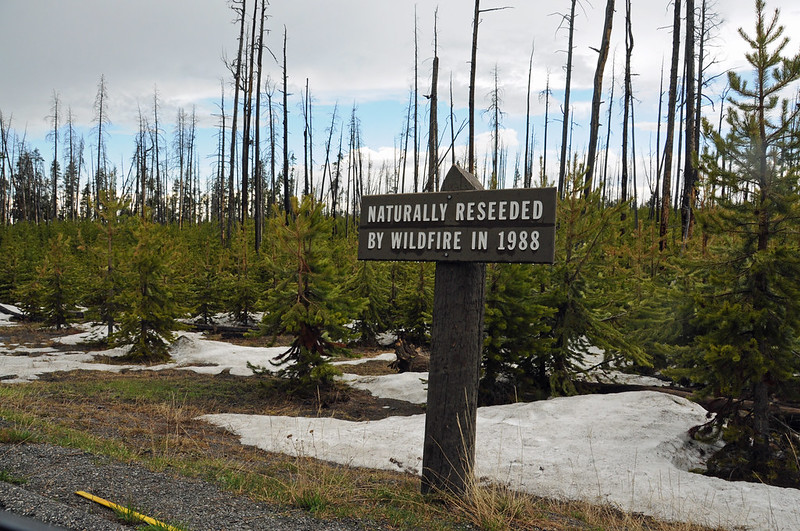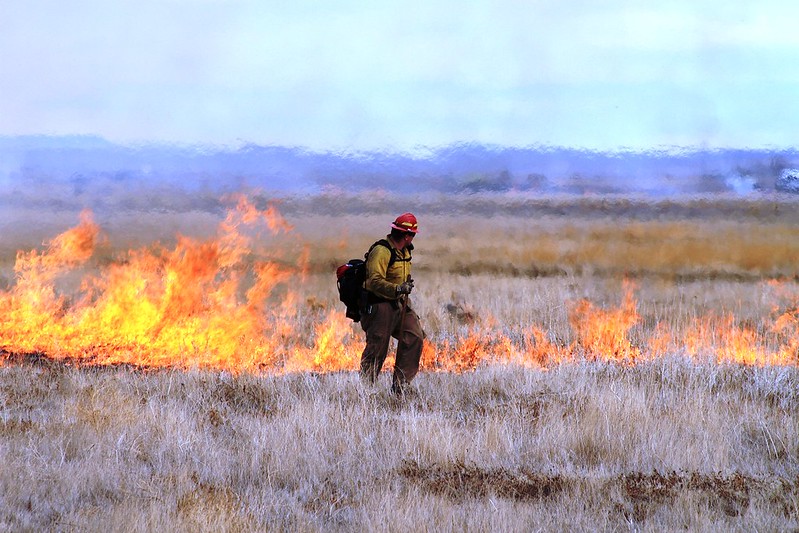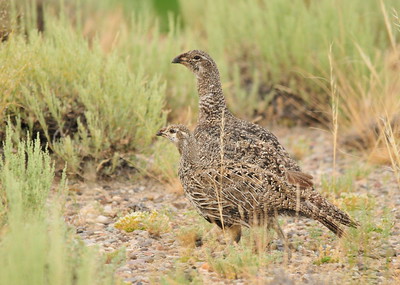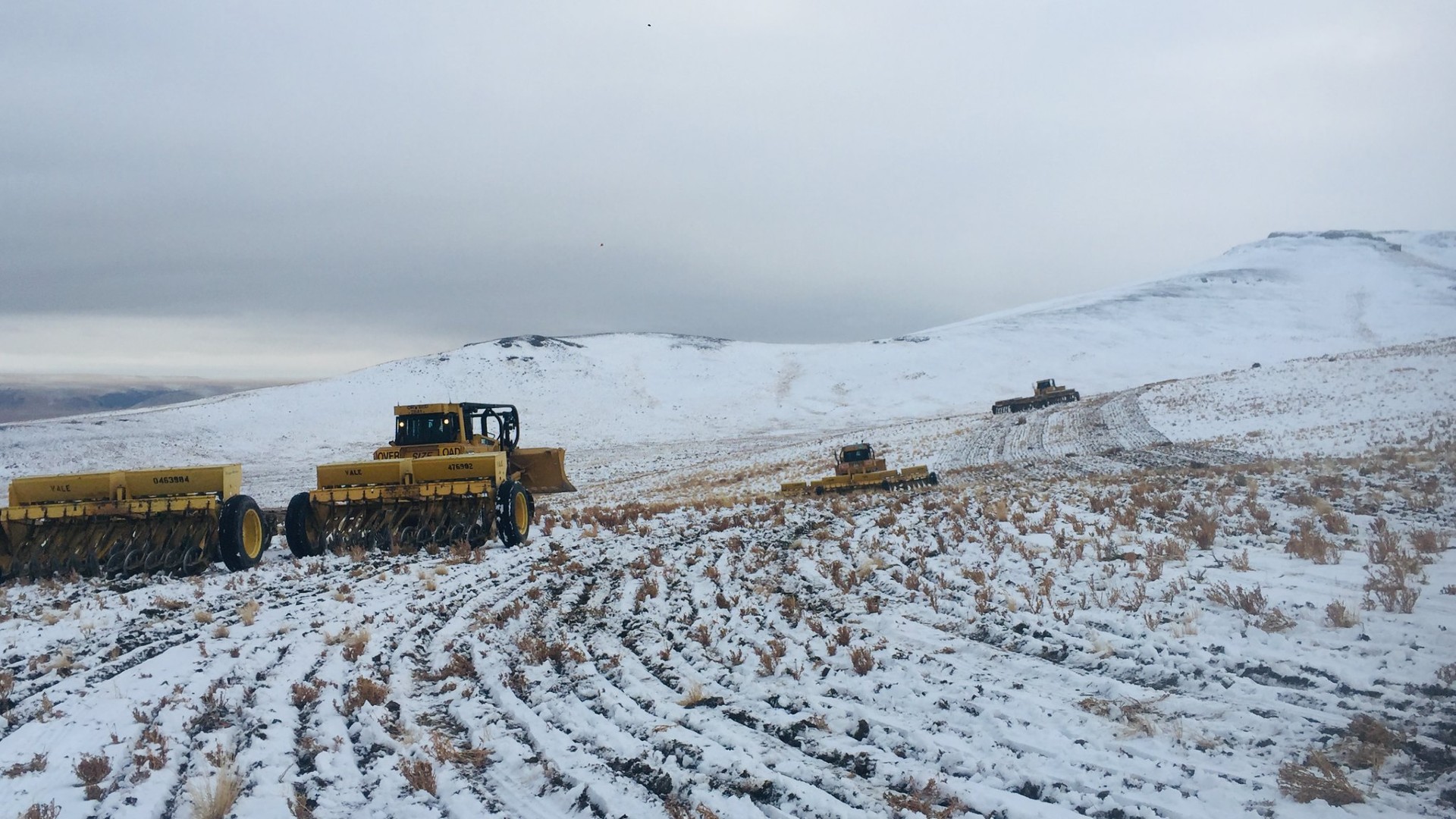In 2017 the Thomas fire raged through 281,893 acres in Ventura and Santa Barbara counties, California, leaving in its wake a blackened expanse of land, burned vegetation, and more than 1,000 destroyed buildings.
More tragedy soon followed. When rains finally arrived in January 2018, the waters hit hills where grasses, trees and shrubs had all been burned away. The resulting mudslides, exacerbated by the fire-hardened soil, killed more than 20 people.
Perhaps that’s one of the reasons some local residents wanted to take action right away, in the weeks after the fire, to bring life and color back to the charred hillsides by scattering the ground with seeds of the state’s iconic California poppy.
Such efforts wouldn’t have prevented the mudslides, but the impulse to do something after a wildfire is natural, especially following a deadly catastrophe. But is reseeding a burned landscape the right way to go?
It turns out reseeding isn’t always ecologically beneficial or effective. Most of it is undertaken with the intent of curbing erosion or limiting the spread of invasive plants. But according to a growing field of research, in some ecosystems reseeding doesn’t have those desired effects — and can even inhibit the ability of native plant communities to recover. That, in turn, can harm other native wildlife and even the climate.
Sometimes, experts say, the best thing to do is actually nothing. But that can be hard for the public to understand when wildfires hit so close to home.
“The general public still sometimes expects to see the helicopters flying over the chaparral after fires, throwing that grass seed out there,” says Jan Beyers, an emeritus scientist with the Forest Service’s Pacific Southwest Research Station.
“Well-meaning community groups and even private citizens think they’re actually helping by reseeding and don’t know that they may be causing more harm,” says Liv O’Keeffe, senior director of communications and engagement at California Native Plant Society.
It’s not just a few eager residents who feel the call to reseed. Reseeding’s been a common tactic of state and federal agencies across many parts of the western United States for decades, and still is in some areas. In the Great Basin alone, millions of acres of public lands have been reseeded after wildfires — a lot of them with non-native grasses.
So with evidence mounting against large-scale reseeding, why is it still done?
That answer varies across the West, as each ecosystem presents unique challenges. And things get even more complicated in places where we’ve caused the biggest disruptions to the environment — land that been has heavily developed, overrun by invasive species, or trampled by hordes of hungry cattle.
The Hard Truth: Doing Nothing Works
“Most of the time, reseeding after wildfire is not a good idea,” says Andrea Williams, the director of plant science at the California Native Plant Society.
The appropriate action to take post-fire, according to the organization’s newly published fire-recovery guide, depends on where the fire happened, how intensely it burned, and the type of habitat affected. And sometimes the worst damage comes not the fire itself, but from firefighting with bulldozers and other heavy machinery that take a big toll on the environment. In those cases, more advanced restoration, including reseeding, could be needed.
In much of California, though, reseeding isn’t necessary, she says. Wildfire is a natural occurrence in the state, and most native plants are adapted to it. Some species will only germinate after a fire, while others benefit from the light and space that’s created in burned areas. In the weeks and months following a wildfire, nature can put on a show.
“If you get the appropriate timing and intensity, you’ll get native wildflowers that you don’t see except after a burn, like the fire poppy,” says Williams. “And that’s because the char and ash produce chemicals that signal them to come up and bloom and take advantage of that space in the shrubland that’s there after a fire.”
Within about five months, native shrubs and oaks will also start sprouting, she says.
“So seeding in those instances, particularly with non-native species and even with native species, is generally a bad idea.”
Unfortunately, that’s exactly what landowners and land managers have done for decades.
“We’d load up an airplane with grass seeds and fly the entire fire area and just drop seed,” says Eric Huff, staff chief of the Forest Practice Program for the California Department of Forestry and Fire Protection (Cal Fire). “Everyone felt good — like they’d done something to arrest erosion — but grass-seeding over large scales like that was not effective.”

In fact, the majority of studies conducted in forests across the West showed that seeded areas were no better at preventing erosion than non-seeded areas, according to a 2011 survey of the scientific literature by researchers from the U.S. Forest Service and Northern Arizona University. Even when seeded sites did produce more plant cover on the ground, it was rarely enough in the first two years to help hold soils in place.
Seeding is also done to help prevent invasive species — plants that originate in another area and, once introduced, pose a threat to their new habitat’s biological diversity — from taking over before other species can recover. But on that front, researchers have found it’s mostly a toss-up — it only works about half the time. That’s because most of the treatments meant to limit invasive species actually used non-native seeds, which, though they may not be aggressively harmful, can still crowd out native plants.
“This review,” the authors wrote in their study, “suggests that post-fire seeding does little to protect soil in the short term, has equivocal effect on invasion of non-native species, and can have negative effects on native vegetation recovery with possible long-term ecological consequences.”
Beyers, who was one of the contributing scientists, says the mounting research helped change practices among agency staff in California. But it’s been harder to get the message out to the general public, and other states have continued the practice — for example, Arizona, where a recent burn was sprayed with barley seeds.
When non-native grasses are reseeded they can do real harm.
One of the places where this has been apparent is in chaparral, the shrub-dominated ecosystem that thrives in California’s Mediterranean climate and is home to many of the state’s native plant species. Introducing non-native grasses there often ends up providing fuel for fires, says Richard Halsey, director of the California Chaparral Institute. Most of the grasses are annuals that die out by summer and provide dry tinder, often referred to as “flash fuels,” that ignite more quickly than studier shrubs during summer and fall fire season.
Chaparral is better left alone after a wildfire. Reseeding that was previously carried out by state and federal agencies “only destroyed ecosystem integrity and ended up causing a more flammable environment,” he says. “Unless the landscape’s been overrun by weeds already, people just ought to go home and leave the place alone and not introduce anything else into the system.”
Reseeding efforts, to him, are just “litigation mitigation” — a way for municipalities to say they’ve at least done something after a fire, even if it’s not effective. “The city or the county could say, ‘We did what we could, we’re sorry the hillside came through your living room when it rained,’” he says.
Huff says Cal Fire generally advises against reseeding with grasses, excepted in limited circumstances and for small areas, like a 100-square-foot space around a creek or another municipal water source. The agency does work with local landowners to replant trees after wildfires, though. The program uses mostly seedlings that are 1-2 years old. “We follow a specific seed-zone map that matches native species with the proper elevation,” says Huff.
Land managers have mostly adapted. A more common practice than seeding these days is mulching, which can yield some better erosion-prevention results, she says, but she cautions that the mulch needs to be free of weed seeds, a common problem in straw and wood-chip mulches, to avoid creating the same problems that happen with intentional reseeding.
Cheatgrass and Cows
Out in the Great Basin — the sweeping expanse dominated by sagebrush steppe that stretches across the intermountain West — we find a different situation.
Reseeding after wildfires here is still a common practice, says Francis Kilkenny, a research biologist with the Forest Service and the technical lead of the Great Basin Native Plant Project, a joint effort with the Service and Bureau of Land Management.
That’s because these lower, drier elevations can be prone to “recovery failures,” he says, as opposed to forested ecosystems which tend to have more moisture and a better chance of natural recovery.
A bedeviling invasive species unintentionally introduced in the United States in the late 1800s makes recovery in the steppes even harder. Cheatgrass (Bromus tectorum) is often the first plant to establish itself after a wildfire. An annual, dense-growing grass that dies and dries out by summer, it’s also a notorious “flash fuel” that can drive more wildfires, creating a vicious cycle. It also dies earlier than native vegetation, extending the fire season.
To break that pattern, land managers will often seed an area after a wildfire with other quick-growing grasses. Crested wheatgrass (Agropyron cristatum), a fire-tolerant, non-native perennial, is a favorite. It comes with its own problems, but it’s good at outcompeting cheatgrass, and cattle enjoy it.
And that’s another objective of managers on public lands — providing forage for grazing.
Cattle on the landscape, however, create another kind of vicious cycle. They trample the biological soil crust that provides cover between native bunchgrasses. Intact, the crust can prevent cheatgrass seeds from taking hold, but once it’s been broken, the seeds have an easier time.
Cheatgrass invades after soils have been degraded by grazing, road building and other development, or off-road vehicles. So more grazing can mean more cheatgrass, which means more fire, which means more wheatgrass seeding, which results in more forage for cattle.
Across Nevada this kind of reseeding of non-native grasses has turned the sagebrush steppe into “basically a cow range with monocultures of crested wheatgrass,” says Laura Cunningham, the California director of the nonprofit Western Watersheds Project. “And that’s not a good habitat for other native species like sage grouse and mule deer.”
Reseeding with non-native grasses like crested wheatgrass to beat out cheatgrass achieves the goals of suppressing invasive species and providing forage, but it comes at the expense of biological diversity, as crested wheatgrass also outcompetes almost every other native species it’s been measured against, says Kilkenny.
The cost of that tradeoff hasn’t gone unnoticed.
“Negative long-term effects of these species [of non-native grasses] on ecosystem functioning, biodiversity, and wildlife habitat have been documented,” wrote Kilkenny and other scientists in a 2019 study.
And that has led to a change in practice.

From 1940 to 1980 virtually all reseeding was done with a mix of non-native forage grass, dominated by crested wheatgrass. In the following two decades, land managers began using some native seeds. By the turn of the century, there were more native seeds than non-native being used in reseeding and the mixes often contained a combination of grasses, forbs and shrubs. The most commonly used native species are Sandberg bluegrass (Poa secunda), Lewis flax (Linum lewisii) and big sagebrush (Artemisia tridentata).“Part of the reason for that is that there’s been more development of native species, so there are more options on the market,” says Kilkenny. Short supply and high costs for native seeds have previously been cited as limiting factors.
But not every kind of native seed is cheap or easy to get. Some seeds, like sagebrush, must be harvested from wild plants, and growing seedlings often requires planting them by hand rather than having a machine toss them in bulk. That’s why land managers tend to favor seeds for perennial grasses that grow in a row-crop type environment.
“The technology that’s used to grow wheat has been transferred to growing these native bunchgrasses,” says Kilkenny.
It’s still rare to find native-only seed mixes being used. But research has shown that when it does happen, they can do nearly as well as crested wheatgrass in competing with the dreaded cheatgrass.
Still, progress continues. A 2017 study led by USGS ecologist David S. Pilliod analyzed treatments of public lands and found that the upward trend in reseeding with native species is likely to continue because, “research suggests that locally adapted native seeds can perform better than seeds from distant locations or elevations.”
The Need for Natives
Protecting native plants and working to restore areas where they’ve been displaced can be slow going — but a number of other native residents depend on the outcome. One of those is the greater sage-grouse (Centrocercus urophasianus), which has become a species of conservation concern.
The bird, which ranges across the Great Basin, slipped in numbers to fewer than 200,000 as sagebrush-steppe habitat was lost to fire, development and invasive species. Sage grouse chicks depend on the cover of sagebrush and other shrubs to hide from predators and they need the native forbs and insects that grow in these intact habits for food.

“Chick rearing is dependent on having a highly biodiverse plant community,” says Kilkenny. “So if your goal is to increase sage grouse habitat, you would want to try to use natives as much as possible.” Post-fire habitats reseeded with crested wheatgrass lack ecological diversity and have been shown to be much lower in insect diversity, including pollinators, he says.
Helping to restore native plant communities in the sagebrush steppe provides both biological diversity and structural diversity — which will be key to boosting numbers for the greater sage-grouse.
Maintaining biodiverse plant communities is important not just in the Great Basin, of course, but everywhere we want healthy ecosystems.
Native plants have coevolved with native pollinators like bees. “The whole system of life depends on the plants and the complexity of the native species that are locally adapted to that area,” says Williams, of the California Native Plant Society.
Biodiversity and healthy native plant communities will also be even more important as a warming climate changes the world around us.
“What people are pushing these days is to have resilient systems,” she says. “And the basis of a resilient system is a diverse system.”
![]()


